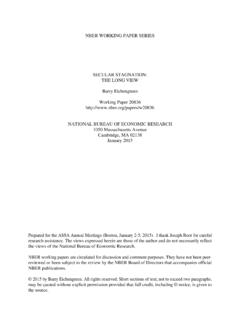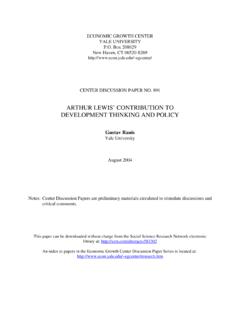Transcription of FRONTIER FIRMS, TECHNOLOGY DIFFUSION AND PUBLIC …
1 THE FUTURE OF PRODUCTIVITY:MAIN BACKGROUND PAPERSFRONTIER FIRMS, TECHNOLOGY DIFFUSION AND PUBLIC POLICY: MICRO EVIDENCE FROM OECD COUNTRIESBy Dan Andrews, Chiara Criscuolo and Peter N. Gal 1 The statistical data for Israel are supplied by and under the responsibility of the relevant Israeli authorities. The use of such data by the OECD is without prejudice to the status of the Golan Heights, East Jerusalem and Israeli settlements in the West Bank under the terms of international law. OECD (2015) You can copy, download or print OECD content for your own use, and you can include excerpts from OECD publications, databases and multimedia products in your own documents, presentations, blogs, websites and teaching materials, provided that suitable acknowledgment of OECD as source and copyright owner is given.
2 All requests for commercial use and translation rights should be submitted to 2 ABSTRACT/RESUM FRONTIER Firms, TECHNOLOGY DIFFUSION and PUBLIC Policy: Micro Evidence from OECD Countries This paper analyses the characteristics of firms that operate at the global productivity FRONTIER and their relationship with other firms in the economy, focusing on the DIFFUSION of global productivity gains and the policies that facilitate it. Firms at the global productivity FRONTIER defined as the most productive firms in each two-digit industry across 23 countries are typically larger, more profitable, younger and more likely to patent and be part of a multinational group than other firms. Despite the slowdown in aggregate productivity, productivity growth at the global FRONTIER remained robust over the 2000s.
3 At the same time, the rising productivity gap between the global FRONTIER and other firms raises key questions about why seemingly non-rival technologies do not diffuse to all firms. The analysis reveals a highly uneven process of technological DIFFUSION , which is consistent with a model whereby global FRONTIER technologies only diffuse to laggards once they are adapted to country-specific circumstances by the most productive firms within each country ( national FRONTIER firms). This motivates an analysis of the sources of differences in the productivity and size of national FRONTIER firms vis- -vis the global FRONTIER and the catch-up of laggard firms to the national productivity FRONTIER . Econometric analysis suggests that well-designed framework policies can aid productivity DIFFUSION by sharpening firms incentives for technological adoption and by promoting a market environment that reallocates resources to the most productive firms.
4 There is also a role for R&D tax incentives, business-university R&D collaboration and patent protection but trade-offs emerge which can inform the design of innovation-specific policies. JEL classification: O30, O40, O43, O57, M13. Keywords: productivity, reallocation, knowledge DIFFUSION , firm dynamics. ** Entreprises en pointe, DIFFUSION des technologies et politiques publiques : microdonn es des pays de l OCDE Ce document analyse les caract ristiques des entreprises qui se situent la fronti re mondiale en mati re de productivit et leurs relations avec les autres entreprises de l conomie. Les entreprises la fronti re de la productivit mondiale que l on d finit comme tant les entreprises les plus productives dans chaque industrie correspondant un code deux chiffres de la classification des activit s conomiques, dans 23 pays sont en g n ral de plus grande taille, plus rentables, plus jeunes, pr sentent une plus grande propension breveter et font plus souvent partie d un grand groupe multinational que les autres entreprises.
5 Malgr le ralentissement de la croissance de la productivit globale, la croissance la fronti re mondiale est demeur e robuste pendant les ann es 2000, tandis que le creusement de l cart de productivit entre les entreprises la fronti re et les autres soul ve d importantes questions quant aux raisons faisant que des technologies non rivales n atteignent pas toutes les entreprises. cet gard, l analyse concorde avec un mod le selon lequel les technologies la fronti re mondiale ne rejoignent les entreprises retardataires que lorsqu elles sont adapt es aux exigences propres chaque pays des entreprises qui se situent la fronti re nationale. Ce processus tr s in gal de DIFFUSION des technologies justifie une analyse des diff rences internationales en ce qui concerne les carts de performances entre les entreprises la fronti re mondiale et celles qui se situent la fronti re nationale, et le rattrapage des entreprises retardataires par rapport la fronti re de productivit nationale.
6 L analyse conom trique donne penser que des politiques-cadres judicieuses peuvent favoriser la DIFFUSION de la productivit en affinant les motivations des entreprises adopter des technologies nouvelles et en promouvant un environnement de march qui r affecte les ressources aux entreprises les plus productives. Les incitations fiscales la R-D, la collaboration entreprises-universit s en R-D et la protection par brevet ont un r le jouer, mais des arbitrages nouveaux peuvent inspirer des politiques sp cifiques en faveur de l innovation. Classification JEL : O30, O40, O43, O57, M13. Mots-cl s : productivit , r affectation, DIFFUSION du savoir, dynamique des entreprises. 3 TABLE OF CONTENTS FRONTIER FIRMS, TECHNOLOGY DIFFUSION AND PUBLIC POLICY: MICRO EVIDENCE FROM OECD COUNTRIES.
7 5 1. Introduction .. 5 2. firm level data: sources, key definitions and challenges .. 8 Measuring the productivity FRONTIER .. 8 Representativeness issues .. 9 3. What is happening at the global productivity FRONTIER ? .. 10 Characteristics of FRONTIER firms .. 10 Has productivity growth at the FRONTIER slowed over time? .. 11 Changes in the characteristics of FRONTIER firms along other dimensions .. 13 4. Performance gaps between global FRONTIER and national FRONTIER firms .. 14 Building blocks: a productivity decomposition .. 14 A counterfactual exercise .. 14 Aggregate implications of improving the performance on national FRONTIER firms .. 15 Empirical framework to explore the role of policies .. 16 Empirical links between policies and performance gaps .. 19 5. Catch-up to the national productivity FRONTIER .
8 23 Distance to which FRONTIER ? .. 24 Empirical links between policies and catch-up to the national FRONTIER .. 25 6. Conclusion and policy discussion .. 29 REFERENCES .. 31 APPENDIX .. 33 Tables Table 1. Mean firm characteristics: FRONTIER firms vs other firms .. 10 Table 2. firm age at entry into the global productivity FRONTIER .. 11 Table 3. Persistence in the global FRONTIER .. 11 Table 4. Policy and structural indicators and relevant industry characteristics in difference-in-differences 18 Table 5. The global-national FRONTIER unweighted average productivity gap and PUBLIC policy .. 20 Table 6. The global-national FRONTIER size gap and PUBLIC policy .. 22 Table 7. The national FRONTIER exerts a stronger pull than the global FRONTIER .. 24 Table 8. PUBLIC policies and MFP convergence to the national productivity FRONTIER .
9 27 Table A1. Countries that have firms at the global FRONTIER .. 33 Table A2. The difference in average age between 2001 and 2009 .. 33 Figures Figure 1. Firms at the global FRONTIER have become more productive than other firms over time .. 12 Figure 2. Firms at the global productivity FRONTIER have become 13 4 Figure 3. Performance gaps between the national and global FRONTIER : a two-country example .. 16 Figure 4. Impact on industry productivity of policy reforms that enhance the ability of national FRONTIER firms to attract resources and grow .. 23 Figure 5. Impact of policy reforms on the MFP growth of laggard firms, 2005 .. 28 Figure A1. Robustness to defining the global FRONTIER in terms of a fixed proportion of firms, labour productivity .. 34 Figure A2. Robustness to using MFP to define the global productivity FRONTIER .
10 35 Figure A3. Robustness to using turnover-based labour productivity to define the global productivity FRONTIER .. 36 Figure A4. Robustness of the diverging FRONTIER : balanced sample .. 37 Figure A5. Robustness to leaving out non-headquarter group-affiliate firms .. 38 5 FRONTIER FIRMS, TECHNOLOGY DIFFUSION AND PUBLIC POLICY: MICRO EVIDENCE FROM OECD COUNTRIES By Dan Andrews, Chiara Criscuolo and Peter N. Gal1 1. Introduction 1. Aggregate productivity growth slowed in many OECD economies over the past decade. While this partly reflects cyclical factors, productivity growth slowed even before the crisis and continued to linger after the financial crisis, raising concerns that there may be structural dimensions to the slowdown. Indeed, some economists have argued that we are faced with secular stagnation ( Summers, 2013), with accounts that focus on supply-side aspects of the slowdown in potential output growth particularly relevant.















